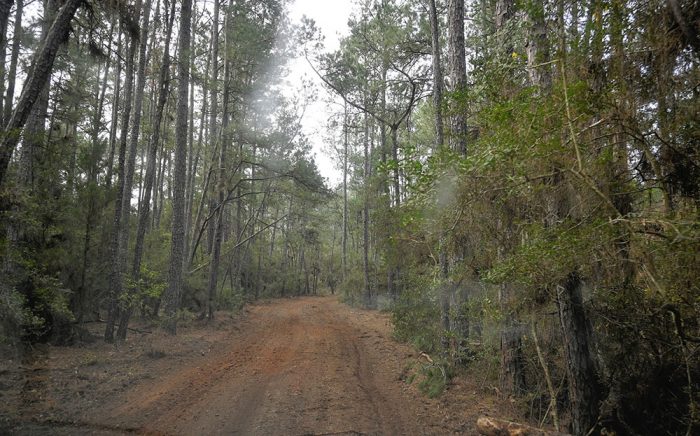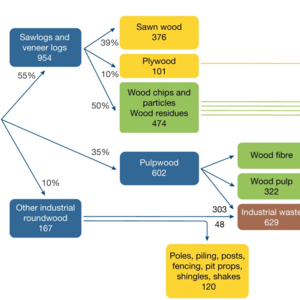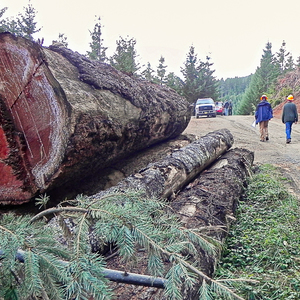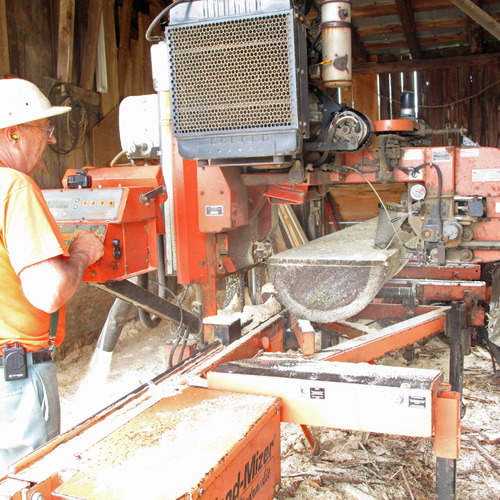
I have a friend who owns forests. He invited me to see how a timberland owner produces lumber. As a former carpenter, I felt it was high time to learn where the raw materials of my trade comes from and how trees are converted into 2x4s. A quick estimate on my calculator suggests that I am responsible for consuming about 1400 acres of forest during my 40 years as a home builder. So, I jumped at the chance to learn firsthand about the full cycle of this consumption.
The Canadian company West Fraser is the largest softwood supplier in the world and the third largest in the U.S., behind Weyerhaeuser and Georgia Pacific. It owns the Angelina lumber mill, a state-of-the-art facility near Lufkin, TX., which is two hours north of Houston. My friend arranged for me to tour the facility with Wiley Quarles, the general manager, and two silviculturists from American Forest Management.
Silviculture and forest sustainability

Silviculture comes from the Latin silvi (forest) and culture (growing). As with agriculture, which is about food production (and lots of it), those cultivating timber seek to conserve and improve the quality and yield of their forest stands. I first heard about silviculture and the technical sophistication of sustainable forest cultivation from Willie Newman, who talks about longleaf pine with the passion of a wine connoisseur, and his aide-de-camp, Andrew Boughton.
…
Weekly Newsletter
Get building science and energy efficiency advice, plus special offers, in your inbox.

This article is only available to GBA Prime Members
Sign up for a free trial and get instant access to this article as well as GBA’s complete library of premium articles and construction details.
Start Free TrialAlready a member? Log in















36 Comments
Like industrial agriculture, everything is optimized for production and profit. Could we grow food, or lumber, to suit our needs without industrialization? Probably not. But we should be honest that the industrial processes, in both cases, are largely single minded and thus have externalities and downsides compared to more comprehensive and wholistic models.
maine-tyler,
" in both cases, are largely single minded and thus have externalities and downsides"
None of which were even touched on in this description of current forestry practices.
I live in an area whose primary economic activity is logging and have worked in the industry. It is very efficient tree farming - and as you say, much like industrial scale agriculture it comes with the problems associated with harvesting large areas of mono-culture: Wildlife habitat degradation, depleted watersheds, increased susceptibility to forest fires, and pest infestations. These may well be offset by the efficiencies that modern logging affords us, but it would have been nice to see them discussed.
Malcolm,
Fernando Pages Ruiz notes that "three-quarters of all the trees sowed last year were planted by forest products companies and private timberland owners. The forestry business is about growing and harvesting trees, so reforestation is important to the industry as it guarantees viability and longevity."
I don't know if he's talking about seeds that were sown or tree seedlings that were transplanted -- but it seems that he is talking about the conversion of natural forests (which are being cut down by logging companies) into tree plantations. As I noted in my recent article, a tree plantation is not a forest -- which leads me to conclude that we're not talking about "the forestry business" but "the lumber business."
Martin,
Many of my friends are local ex-loggers. I could (and do) listen for hours as they describe the fascinating processes involved with harvesting. Working the spar poles with mile of cables, or building booms to take the logs up the coast to the mills. So I appreciate Fernando's descriptions - much as I no doubt would hearing about coal mining in Virginia. But you can't just be a credulous observer. Within five minutes of my house I could show you the creeks clogged with runoff, or choked by blow-downs, in the ineffectively small riparian buffers. The large single species plantations which contain shockingly few local wildlife.
Again, with the way we have structured our present economy, I don't have any easy answers, but painting the present system and methods as something we should pause and be grateful for seems a bit rich.
“[Deleted]”
I did not write this for GBA. I would not have. I wrote it only as an informational article for FHB. They decided to post it here, where I knew it would not find a kind reception. Had I written it for GBA, I would have focussed more on GBA reader concerns.
In response to your question, they plant seedlings. And in the article, I make clear that the industry term is silviculture -- like agriculture -- and forestry is the only popular name since most people don't know Latin. You would not call a wheat field a meadow, and a planted timberland (what they call it) is not properly a forest. But were it not for silviculture, our only "forested" areas would be in state and national parks. I was surprised to learn that almost all heavily treed areas outside parks are indeed silviculture and not naturally occurring. I learned this during my days as a CAT adjuster after hurricanes damaged vast woodland areas. Insurance companies had to respond to millions of trees in Florida and Louisiana. These woodlands look natural as you drive down the roads, trees lining both sides for miles on end, but they are no more natural than a cornfield in Iowa.
Fernando,
You wrote, "But were it not for silviculture, our only 'forested' areas would be in state and national parks."
That's not true. As I wrote in my recent article, 78% of the land in my state of Vermont consists of forests. These are not national parks (although we do have some wonderful state parks). Nor are they single-species plantations. They are, for the most part, privately owned parcels -- which make up far more of Vermont's forests than are found in our state parks -- and they were, for the most part, never planted by humans. They consist of a wide variety of softwood and hardwood species that were planted by the wind and the birds.
“[Deleted]”
I mentioned the reintroduction of native species. This responds to your question. The original forests were not a potpourri of trees but a monoculture of longleaf. Trees create monoculture by dropping needles that inhibit all other species from growing. This is why you have pine forests, redwood forests, and teak forests rather than rainbow forests.
Fernando,
You wrote, "The original forests were not a potpourri of trees but a monoculture of longleaf."
I don't now what region of North America you're writing about, but that generalization doesn't apply to most of North America. For example, while the current forests in the Northeast differ in species composition from the species in pre-Columbian times, our forests were never a monoculture. One source lists the following species in the pre-Columbian forests of the Northeast: cedar, fir, spruce, beech, birch, maple, ash, hemlock, pine, cherry, chestnut, oak, and hickory.
I was looking up percentages of forests (the multi-species, none cultivated woodlands) vs. timberlands (grown for eventual harvest). I noted the timberland dwarfs the forests—251,068 vs. 765,493. I don't know about Vermont, but it's a small part of the USA. I'd say in Texas, very few woodlands were planted by nature. Forestry (in the commercial sense) is not a highly visible enterprise since so much of the woodlands simply stand around for decades and even half a century between harvests. I don't see today's timber industry as a black-hatted villain.
https://www.statista.com/statistics/252849/total-us-area-of-timberland-2012-by-ownership/#:~:text=This%20statistic%20depicts%20the%20total,to%20some%20765.5%20million%20acres.
Allelopathy is a chemical process that a plant uses to keep other plants from growing too close to it. Some pine trees are allelopathic. When their needles fall onto the ground, and they keep unwanted plants from growing near the pine tree. This is why, when you read about Souther Forests populated with longleaf, you read passages like this: "When Alabama became a state in 1819, up to 90 million acres (140,000 square miles) of longleaf pine forests stretched across the southeastern United States. That’s an area almost the size of Montana — an area larger than all the national parks combined — all covered in towering pine trees. Early settlers described the forests as “limitless.”"
It's certainly not true of the rain forests here on the west coast. In any one place you will have a dominant species but they are a mix of cedar, fir, hemlock, spruce and pine, with areas of maple, arbutus, alder, garry oak and cherry where local conditions favour them.
Naturally seeded forests are very different than planted ones. They are not spaced at 6 ft oc, and feature clearings which allow other species and undergrowth to thrive. Their diversity also helps protect them against blights that can devastate single species plantations as we have seen with the Mountain Pine Beetle.
"Trees create monoculture by dropping needles that inhibit all other species from growing."
I'm sorry this is just downright crazy talk. Perhaps there are certain regimes (especially fire disturbance ones) where a singe tree species will heavily dominate due to the succession following the disturbance, (you occasionally see thickets of poorly formed white pine here that formed in a soil disturbed abandoned field, but it is transitory) but for most parts of the world, trees most certainly do not, when left alone, default to monocultures.
maine_tyler,
Disturbed sites here are initially dominated by alders, which have a short lifespan, and when they fall they decay quickly, fixing nitrogen in the soil, making it fertile ground for the conifers that follow.
Sitka spruce and western hemlock prefer growing on nurse logs, so they have to wait for cedar and firs to die to get established. These are largely symbiotic relationships which seem to favour diversity, not mono-cultures.
"You may have noticed that the lumber you use today has improved dramatically from the 2x4s you nailed up 20 years ago—it’s much straighter, cleaner, and with fewer knots."
Heh... well, I wasn't using lumber 20 years ago to be able to compare but if you consider lumber anything other than HORRIBLE than you get much better quality lumber than I can get locally! The only way I can get relatively straight and mostly wane-free 2x4s is by hand-selecting the 1-out-of-10 at Home Depot or Lowes. An order from a commercial building supplier results in what mostly looks like scraps.
I am definitely envious of those that live in lumber-rich areas!
Kurt, here in Maine we are timber-rich but framing lumber has only gotten worse in the 35 years I've been paying attention. I wonder how different forestry and milling practices are in other parts of the continent.
We need lumber for millions of homes. Would GBA readers prefer we return to cutting natural forests rather than planting them for future harvest?
I was most impressed by the replanting of endemic species in anticipation of climate change and the care taken of wildlife despite the cutting. If wood is green, how should we supply enough for millions of buildings?
Fernando,
Q. "Would GBA readers prefer we return to cutting natural forests rather than planting them for future harvest?"
A. I, for one, would answer the question "yes" -- but only if we are judicious in our logging of natural forests.
"almost all heavily treed areas outside parks are indeed silviculture and not naturally occurring"
"Would GBA readers prefer we return to cutting natural forests rather than planting them for future harvest?"
I think there's a bit of a misconception here. With the exception of a very very few places, no forests are 'natural' in the sense of being untouched by european colonists. Most were cut at least once and continue to be cut-- all whilst not being a plantation.
In fact, cutting from a plantation is only not 'cutting a natural forest' because we have made it a plantation. In other words, we deleted an entire 'natural forest' (using the term natural loosely here ) and replaced it with something else. So yes, cutting sustainably within a forest that is managed for a multitude of values as oppossed to exclusively as a plantation is almost certainly desirable in a number of ways.
That said, your question: "If wood is green, how should we supply enough for millions of buildings?"
Is very important. There's no easy answers. I'd start by saying that wood isn't necessarily inherently green. There's a spectrum. But then I would admit that if not for the calculating, brutal, efficiency of plantations, it may be difficult to meet demand. This is much akin to the industrial agriculture vs local organic food debate. One is clearly 'better' in terms of minimizing externalities and providing additional value beyond the one product, but it's not clear if they can produce the quantity of good we demand. I would like to think there is a middle ground that could thread the needle.
Thank you, maine_tyler, for adding, "I think there's a bit of a misconception here. Except for very few places, no forests are 'natural' in the sense of being untouched by European colonists. Most were cut at least once and continue to be cut while not being a plantation." Many privately owned forests will be cut, and the families will keep them as an investment and sell them eventually. It takes a very long time to obtain a financially viable timberland, so no logging does not mean it's not headed for a lumber yard eventually. Fifty-six percent of our forest lands are in private ownership. In the eastern half of our country, 83 percent of the forest land is in private ownership. There is no restriction to logging this land, and much if not most, will be logged. However, thanks to better forestry management practices, the US is no longer in danger of deforestation, as it was last century. The threat to forests is not loggers but wildfires and drought. Idealism is great and also wrongheaded. Putting wood to good use is a key strategy for climate mitigation. Wood both stores carbon and replaces more carbon-intensive materials. For example, lumber is 8 times less fossil-fuel-intensive than cement and 21 times less fossil-fuel-intensive than steel. Next time you see a logger, tip your hat.
Fernando,
While I appreciate your response and I don't disagree with every aspect of your perspective on this, I'm not clear what in your response really addressed my point, which is that brutally efficient plantation operations that are built solely around the growing of lumber lack certain values that other forests retain-- other forests that do indeed get logged, we agree on that. One of those values happens to be resilience in the face of climate change.
None of this is black and white, and it's certainly very complicated with many variables to weigh. Cheers for engaging in these discussions.
Fernando,
No one is disputing that "fifty-six percent of our forest lands are in private ownership. In the eastern half of our country, 83 percent of the forest land is in private ownership. There is no restriction to logging this land, and much if not most, will be logged."
But this land that you describe does not consist of monoculture plots of same-aged trees -- the classic plantations discussed when you mentioned trees being "sowed" (actually, seedlings being transplanted). These privately owned eastern forests are multi-species stands of trees of varying ages, planted by the wind, the birds, and various mammals -- and occasionally logged.
I don't know what you meant when you wrote, "were it not for silviculture, our only 'forested' areas would be in state and national parks." The privately owned eastern forests we're talking about are owned by farmers, ski areas, resort hotels, hunting clubs, owners of vacation properties, corporate investors, wealthy families, nonprofit conservation agencies, and lots of other types of owners. These are not plantations. These are forests (although not identical to pre-Columbian forests, of course), filled with wild animals and diverse species. To manage their forests, most of these landowners don't apply silviculture principles (in the sense you are using the term, with the analogy to agriculture; I understand you are using "silviculture" to mean the practice of growing a crop of trees).
People take hikes through these forests -- which is why most Americans don't have to travel to national parks to experience a forest.
Martin, I think you were hinting at this, but I just want to point out that Silviculture doesn't (in my experience) just mean plantation growing:
https://www.fs.usda.gov/forestmanagement/vegetation-management/silviculture/index.shtml#:~:text=Silviculture%20is%20the%20art%20and,recreation%20on%20a%20sustainable%20basis.
Maine,
Right. But it's hard to know how Fernando is using the term. He talks about replanting areas that are clear-cut. He has written, "The forestry business is about growing and harvesting trees."
He has written, "On the clear-cut forest floor, after the weevils have moved on, foresters replant trees with improved genetics in containers with fertilizer to give the young sprigs a fighting chance."
He has written, "A planted timberland (what they call it) is not properly a forest. But were it not for silviculture, our only 'forested' areas would be in state and national parks."
He has written, "Almost all heavily treed areas outside parks are indeed silviculture and not naturally occurring."
He has written, "These woodlands look natural as you drive down the roads, trees lining both sides for miles on end, but they are no more natural than a cornfield in Iowa."
Statements like the ones I have quoted led me to think that it's possible that Fernando has a very specific idea about what silviculture consists of.
The type of logging that Fernando describes -- clear cutting followed by the transplantation of rows of seedlings, all the same species, to create a stand of nearly identical same-aged trees, with supplementary chemical fertilizer, to be followed (eventually) by another round of clear cutting -- certainly exists, but it is not the only way that logging happens in the United States. And there is room for debate about whether the type of logging that Fernando describes is a good way to obtain lumber -- especially when Fernando writes, "We have the agricultural industry to thank for our food and silviculturists for our renewable sources of lumber. If you say grace before a meal, consider thanking the forest and the many hands that brought that wood to your job site before firing the first nail of the day."
The agriculture industry has fed many otherwise starving people. It’s one reason we can support so many mouths on Earth. Many of the benefits of science and industry come with a cost. We have been slowly improving and mitigating those costs, social and environmental. Had I known the article would end up in GBA I would not have said some of what you quote, but it is how I feel. I am not a counterculture person. I am for improving the success of our industry by reducing the harm caused in a practical manner. Just as there are organically grown vegetables in the grocery store, there is also industrial produce that feeds many more. The organic producers have become more industrial and agribusiness has improved its practices. The influence goes both ways. What I saw in the timberlands I visited were foresters (that's what they are called) who know a lot about the flora and fauna of the area, and respect it to the point of worship. They prided themselves in following the rules of the most stringent forestry programs on all the tracts they manage, whether certified or not. I left the interview and site visit with a deeper respect for the industry. The chainsaw loggers do not supply the millions of 2x4s needed to house millions needing affordable homes. Every year, it takes one tree, 16 inches in trunk diameter and 100 feet tall, to meet each American’s need for paper, packaging, and lumber products. We have three hundred million people, more or less.
>> "Except for very few places, no forests are 'natural' in the sense of being untouched by European colonists. "
Why would we use that sense of 'natural', when by all accounts the people who lived in the Americas before European colonists regularly touched the forests; through clearing, planting, and (primarily) burning?
frasca,
Everything is natural or nothing is.
But.
I was responding to this:
"Would GBA readers prefer we return to cutting natural forests rather than planting them for future harvest?"
And as such I was making a point that it is wrong to refer to a 'return to cutting natural forests' when indeed these forests have been managed for centuries and beyond as you point out. Natural is a word that can mean just about anything. So I was merely pointing out that these other forests that are not 'plantations' are not some sort of mythical haven never to be unentered with thy skidder or harvester. That said, I do think it is good for some places (sometimes very large places) to be left more or less alone in terms of timber cutting.
If you have a point that falls outside of that response please do expound.
“[Deleted]”
Nothing to argue with, Tyler. I am in complete agreement. One small point is that even a commercial timber plantation is not a mono-crop like a cornfield, soybean field, or ended, a "wild rice" or organic acai berry plantation in Bolivia may be. The timber folk plant one or two species (more and more the most endemic to the region) and then return thirty and fifty years later. All kinds of things grow among the planted trees, and they do not remove or cut those down. It's a very different "plantation." Thank you for your reasonable and well-reasoned coments.
Since I am not an expert, I have sent the GBA comments to the sustainability folks at AWC and await to see if they want to contribute to the discussion. I also sent it to a friend that owns timberlands, it's his family business, and he wrote back thus:
Hi Fernando!
It’s actually not that bad – any problems of using, say fertilizer/ herbicides are incredibly infrequent compared to, say, conventional row crop farming – so like maybe just 1-2X every 25 years instead of every few months or a year – but that said, I do think there are some legitimate points in that, for example, a plantation has terrible diversity of not just flora, but resulting, fauna and insects. That said, I’ve talked to some scientists and frankly once you’ve scrambled the egg, it’s hard to unscramble it (and return it to nature). In addition, certainly, in our locations, it’s [timberland is] better than development. Finally, what’s the point? What do people believe houses, toilet paper, and boxes are made of?
of?
"Finally, what’s the point? What do people believe houses, toilet paper, and boxes are made of?"
The point is that plantations are not the only way to grow wood for harvest. And it's not 'plantations' vs quaint chainsaw harvesting. There really is a lot of diversity in forest management practices that run the gamet. For my part, I probably should not have made the comparison to organic farming. Chainsaw harvesting is mostly obsolete at any significant scale (though I did it paired with a cable skidder for a couple seasons) but many of these 'non-plantation' forests I, and I think Martin, are referring to are still cut with harvesters and such large scale equipment. Many of them do a standup job with that equipment in these diverse, non planted, stands. So long as they pay attention to weather.
I think this is all getting painted with too broad a brush (or pethaps too dichotomous a brush). No disrespect, but it is clear you really don't have much background in the subject of forestry. That's fine and the write-up is well written, but to advocate so strongly for somwthing that is clearly not well understood is a bit strange. And it will illicit disingenuous responses if you ask a corporate forester simple questions as a laymen in order for them to sell their product and livelihood (understandably). It strikes me the response of asking "what's the point, where do we think wood comes from" is because they either think we're stupid or they're stupid. If they don't get the nuance of this topic, they have no business casting stones.
Even within plantation regimes there is certainly a wide range of how well managed it is. Likewise, it's possible and common for non plantation lands to get thrashed. Not black and white.
For me, the take away is not that all plantations are bad, but it's good to be clear headed about the pitfalls of any type of operation. As said, idealism may be somewhat wrong-headed, but head-in-the-sand blind faith in corporate motives is terribley wrong-headed as well, in my opinion. If we're going to accept and embrace the existence of plantations, we should be realistic about both their positives and negatives in order to optimize the system in the true meaning of the word. For those that actually work in the world of forestry or related disciplines, it always can---and should-- get better.
Last point is that there is no 'one and only' best way to manage timber/forests. We need a diversity of forest types and management types to meet a diversity of needs; all the while understanding the pitfalls and benefits of that particular management paradigm.
Tyler, while you say there is more than one way to manage timberlands, you also accuse me of "...head-in-the-sand blind faith in corporate motives." You don't know me; you would not describe me this way if you did. You also choose to excerpt only what you don't like, while the owner of the timber plantation I visited conceded that "... there are some legitimate points in that, for example, a plantation has terrible diversity of not just flora, but resulting, fauna and insects." Touche. I also stated that the forest is managed under green SFC and SFI forestry guidelines. But this discussion feels a lot like the political arguments today. Once I respected the foresters that gave me their time and allowed me to share their story -- and it is their story, not mine, as I am not involved in the timber business in any way -- there's nothing I can say that will make it okay. I stepped over the ideological line. I don't write exposés. I do respect our American industries. I've lived abroad and seen how others manage things like forests. If they are trying to do a good job, and they are, why not present them in a good light? As you said, it's one way, not the only way. I saw and heard nothing that made me want to put them down or talk about how terrible their business was. Do you ever buy wood at home improvement stores? If so, that's your lumber.
Fernando,
I made a simple point that you continuously pushed back against. There is no need to claim this is some line in the sand ideological battle.
I really didn't intend to call your character as being 'head in the sand'. Just like a smart person can do or say dumb things, I was simply saying there are two sides to this story and to only heed one is not helpful. As you say, you were writing a story, not an expose. I am not suggesting your piece should have been the latter. I merely wanted to add a little extra content, but it was pushed back against with what I still beleive was mostly just a desire to be right, despite really not having any expertise or even understanding on the subject. Like I said, that strikes me as a bit odd.
My intent was and is not to disparage your piece or your perspective, but simply to suggest there is more story to be told if folks are interested to hear it.
The comment about 'what is the point' is just dumb and pushing buttons. So yeah, in that sense, I guess it is like political debates and not genuine. Didn't rub me the right way that's for sure, and it's certainly not said from the high ground.
User ...218,
" Finally, what’s the point? What do people believe houses, toilet paper, and boxes are made of?"
What an incredibly reductivist way to look at a complex issue.
Log in or become a member to post a comment.
Sign up Log in